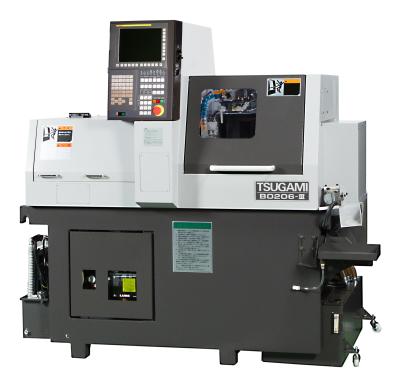
Tsugami/Rem Sales announced the release of four next-generation Tsugami CNC machines. The new models represent the third generation of Tsugami’s Opposed Gang Tool CNC Lathes and are identified with a “-III” after their base model numbers. Newly released models include the B0125-III, B0126-III (pictured), B0205-III and the B0206-III.
The B0125-III and B0126-III are 12 mm machines with five and six axes, respectively. The B0205-III and B0206-III are 20 mm machines with five and six axes, respectively.
“Tsugami machines are already among the heaviest, most rigid machines in their class,” Tsugami/Rem Sales Vice President Mike Mugno said, “but these next generation models are even heavier and more rigid. This means operators can cut more aggressively while experiencing better finishes and longer tool life.”
To increase the machines’ overall rigidity, Tsugami moved the electrical control cabinet from inside the machines to an external position behind the machines and installed two additional support ribs in the space that held the control cabinet. Tsugami also redesigned the machines’ castings, effectively increasing the weight of some machines by over 650 pounds.
“The increased mass is expected to improve cutting ability,” Mugno said. “We anticipate improvements in part runout and straightness, particularly after parts have been transferred from the main spindle to the subspindle.”
Other machine enhancements include increasing the main spindle cross tool speeds from 5,000 rpm to 8,000 rpm, lengthening the back spindle slide stroke on the X2 and Z2 axes, increasing the ball screw diameters, expanding the tool area inside the machines, and expediting chip flow and removal.
Tsugami also updated the machines’ programming software. One new feature, “part program checking”, analyzes the part program code and provides the operator with suggested code optimizations to increase the operating speed of the program and subsequently reduce part cycle time. The thermal displacement compensation function has also been enhanced and can now be used on every linear axis. Other software changes include improvements to the rapid feed override process and automatic back tool post interference protection.
All four machines include Tsugami’s free Abile programming software and all are convertible, meaning they can be run as traditional Swiss-style lathes using a guide bushing or operated with an optional chucker kit, which can be quickly installed.
Contact Details
Related Glossary Terms
- bushing
bushing
Cylindrical sleeve, typically made from high-grade tool steel, inserted into a jig fixture to guide cutting tools. There are three main types: renewable, used in liners that in turn are installed in the jig; press-fit, installed directly in the jig for short production runs; and liner (or master), installed permanently in a jig to receive renewable bushing.
- computer numerical control ( CNC)
computer numerical control ( CNC)
Microprocessor-based controller dedicated to a machine tool that permits the creation or modification of parts. Programmed numerical control activates the machine’s servos and spindle drives and controls the various machining operations. See DNC, direct numerical control; NC, numerical control.
- feed
feed
Rate of change of position of the tool as a whole, relative to the workpiece while cutting.
